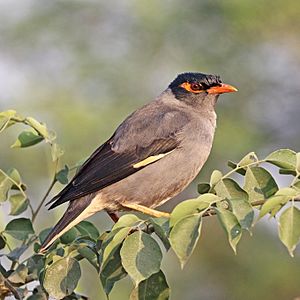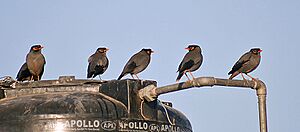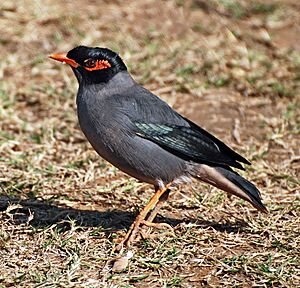Bank myna facts for kids
Quick facts for kids Bank myna |
|
|---|---|
 |
|
| Uttar Pradesh, India | |
| Conservation status | |
| Scientific classification | |
| Genus: |
Acridotheres
|
| Species: |
ginginianus
|
The bank myna (Acridotheres ginginianus) is a cool bird found in northern South Asia. It's a type of myna, which are known for being smart and noisy. This bird looks a lot like the common myna, but it's a bit smaller. You can tell them apart because the bank myna has bright brick-red skin around its eyes, instead of yellow.
Bank mynas are usually a bit greyer underneath. They also have a small tuft of feathers, which makes them look a bit like the jungle myna. You'll often see them in big groups on the flat lands of northern and central India. They even live in towns and cities! Their home range seems to be growing further south into India. These birds get their name because they almost always build their nests in the dirt banks of rivers. They dig tunnels there and live in large groups.
What Do Bank Mynas Look Like?
The bank myna has a black head and black on the sides of its face. Its upper feathers are a slaty grey color. The feathers underneath are a lighter grey, with a pale pink color towards the middle of its belly.
Its wings are black, but they have a white patch near the bottom of the main wing feathers. The tips of its outer tail feathers are a pale pinkish-buff color. The bare skin around its eyes is a bright brick-red. Its legs are yellow, and its eyes are a deep red. Boy and girl bank mynas look the same. Young birds have a browner head and neck.
Where Do Bank Mynas Live?
Bank mynas mostly live in the Indian subcontinent. You can find them from the Indus valley in the west to the Gangetic delta in the east. They live south of the lower parts of the Himalayas. They are rarely found in sheltered valleys.

These birds usually live near open water. Their favorite places are farms and open countryside. However, you'll often see groups of them living inside cities. They hang out in markets and at railway stations. They are very good at finding food scraps left by people. They even follow food trucks at airports!
Bank mynas are also common in Pakistan, especially in the Sind and Punjab areas. They have even started to live in the Kandahar region. While they usually stay in one place, they might move around to find food or better weather. In recent years, more bank mynas have been seen in southern India. They have also started breeding in Assam.
These mynas have been brought to Kuwait, where they now live in the wild. Groups of them have also been seen in the Maldives, Taiwan, and Japan.
How Do Bank Mynas Behave?
Bank mynas are very social birds. They look for food in groups, build their nests together in large colonies, and sleep together in trees. You might see them sitting on farm animals. They are used to crowded towns and let people get close. They often pick up food scraps in markets and garbage dumps.
These birds are quite noisy! They make many different sounds. These include clucks, croaks, screeches, whistles, and even musical warbling sounds.
Bank mynas eat grains, insects, and fruits. Just like the common myna, they sometimes follow grazing animals. They pick up insects that the animals stir up. They even eat ticks off the animals! They also eat ripening crops like sorghum, grapes, and pearl millet. They eat many kinds of insects, including some that are pests to crops. For example, they eat caterpillars that feed on castor plants.
Bank mynas build their nests from April to August. Most birds breed in May and June. They always build their nests in dirt walls. These can be on river banks, embankments, or the sides of open wells. Sometimes, they use holes in brick walls. Nests have even been found between stacks of sugarcane stalks. They dig out the nest hole themselves. The egg chamber can be 4 to 7 feet from the entrance. They line their nests with grass, feathers, and sometimes even snake skin!
A female bank myna usually lays about four or five pale sky-blue or greenish-blue eggs. They might raise two groups of babies in the same season. The eggs hatch after about 13 to 14 days. The baby birds open their eyes after about 5 days. They are ready to fly after about 21 days.



